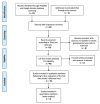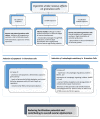Looking Inside the World of Granulosa Cells: The Noxious Effects of Cigarette Smoke
- PMID: 32867029
- PMCID: PMC7555008
- DOI: 10.3390/biomedicines8090309
Looking Inside the World of Granulosa Cells: The Noxious Effects of Cigarette Smoke
Abstract
The detrimental implications of tobacco smoke on systemic health have been widely established during the past few decades. Nonetheless, increasing evidence has begun to shed more light on the serious impact that smoke exposure could also have on mammal reproductive health in terms of overall ovarian dysfunction and gestation. A variety of these complications seem to be causally related to specific chemical substances contained in cigarette smoke and their possible effects on ovarian tissues and cells, such as granulosa cells. Granulosa cells represent the functional unit of the ovary and are able to establish a bidirectional cross-talk relationship with the oocyte during folliculogenesis, which makes them vital for its correct growth and development. Based on these premises, the current review focuses on the presence of related smoke-induced damages in granulosa cells. Data have been grouped according to the studied tobacco constituents and the molecular pathways involved, in order to synthesize their impact on granulosa cells and fertility. Attention is further brought to the correlation between electronic cigarettes and female reproduction, although there have been no investigations so far regarding e-cigarette-related granulosa cell exposure. We summarize how tobacco constituents are able to cause alterations in the "life" of granulosa cells, ranging from luteal steroidogenesis and follicular loss to granulosa cell apoptosis and activation of the autophagic machinery. Further studies have been conducted to elucidate the relationship between lifestyle and fertility as to reduce the morbidity connected with infertility.
Keywords: IVF; cigarette smoke; electronic cigarettes; female reproduction; granulosa cells; infertility; pregnancy.
Conflict of interest statement
The authors declare no conflict of interest.
Figures




Similar articles
-
Grandmaternal smoke exposure reduces female fertility in a murine model, with great-grandmaternal smoke exposure unlikely to have an effect.Hum Reprod. 2017 Jun 1;32(6):1270-1281. doi: 10.1093/humrep/dex073. Hum Reprod. 2017. PMID: 28402417
-
Ovarian intrafollicular processes as a target for cigarette smoke components and selected environmental reproductive disruptors.Endocr Regul. 2005 Jan;39(1):21-32. Endocr Regul. 2005. PMID: 16107135 Review.
-
Scrambled and fried: cigarette smoke exposure causes antral follicle destruction and oocyte dysfunction through oxidative stress.Toxicol Appl Pharmacol. 2013 Sep 1;271(2):156-67. doi: 10.1016/j.taap.2013.05.009. Epub 2013 May 18. Toxicol Appl Pharmacol. 2013. PMID: 23693141
-
Cigarette smoke impairs granulosa cell proliferation and oocyte growth after exposure cessation in young Swiss mice: an experimental study.J Ovarian Res. 2012 Sep 20;5(1):25. doi: 10.1186/1757-2215-5-25. J Ovarian Res. 2012. PMID: 22995067 Free PMC article.
-
Oocyte-somatic cell interactions in the human ovary-novel role of bone morphogenetic proteins and growth differentiation factors.Hum Reprod Update. 2016 Dec;23(1):1-18. doi: 10.1093/humupd/dmw039. Epub 2016 Oct 26. Hum Reprod Update. 2016. PMID: 27797914 Free PMC article. Review.
Cited by
-
The Molecular Link between Obesity and the Endometrial Environment: A Starting Point for Female Infertility.Int J Mol Sci. 2024 Jun 22;25(13):6855. doi: 10.3390/ijms25136855. Int J Mol Sci. 2024. PMID: 38999965 Free PMC article. Review.
-
Prevalence and associated factors of infertility among 20-49 year old women in Henan Province, China.Reprod Health. 2021 Dec 20;18(1):254. doi: 10.1186/s12978-021-01298-2. Reprod Health. 2021. PMID: 34930324 Free PMC article.
-
The Role of Lifestyle Intervention in Female Fertility: A Modifiable Factor for Preconception Health.Nutrients. 2025 Jun 25;17(13):2101. doi: 10.3390/nu17132101. Nutrients. 2025. PMID: 40647206 Free PMC article. Review.
-
A Systematic Review of the Effects of High-Fat Diet Exposure on Oocyte and Follicular Quality: A Molecular Point of View.Int J Mol Sci. 2022 Aug 10;23(16):8890. doi: 10.3390/ijms23168890. Int J Mol Sci. 2022. PMID: 36012154 Free PMC article.
-
Impact of Cigarette Smoking on the Expression of Oxidative Stress-Related Genes in Cumulus Cells Retrieved from Healthy Women Undergoing IVF.Int J Mol Sci. 2021 Dec 5;22(23):13147. doi: 10.3390/ijms222313147. Int J Mol Sci. 2021. PMID: 34884952 Free PMC article.
References
-
- U.S. Department of Health and Human Services. U.S. Department of Health and Human Services, Centers for Disease Control and Prevention. National Center for Chronic Disease Prevention and Health Promotion, Office on Smoking and Health . A Report of the Surgeon General: How Tobacco Smoke Causes Disease: What It Means to You. U.S. Department of Health and Human Services, Centers for Disease Control and Prevention; Atlanta, GA, USA: 2010.
Publication types
LinkOut - more resources
Full Text Sources
Miscellaneous

